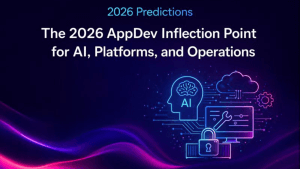Enterprise architecture is on the brink of its next major transformation. After a decade of cloud-native development and platform modernization, the emergence of agentic AI and edge-native applications is catalyzing a new operating model—one defined by location-independent services, ultra-low latency, and autonomous coordination across environments.
In this episode of AppDevANGLE, I spoke with Derek Collison, CEO of Synadia and creator of NATS, to unpack the challenges and opportunities shaping the future of edge computing, agent-based AI, and secure connectivity in a multi-cloud world.
Beyond Cloud-Centric Thinking
While the cloud continues to be critical infrastructure, the shift to edge is now accelerating and may soon surpass the impact of cloud’s initial rise.
“Cloud is the new mainframe. It’s not going away, but interacting directly with cloud isn’t what most people are doing anymore,” said Collison.
According to theCUBE Research, 49% of organizations report increasing investments in edge, while 76% of the world’s top 100 banks are already implementing edge computing initiatives. This expansion isn’t about replicating cloud at the edge, it’s about adapting to a world where data, decisions, and devices live closer to the user and demand real-time autonomy.
Rethinking Architecture for Agentic AI
The next shift won’t just be about deploying applications at the edge but about enabling agents to reason, act, and collaborate across distributed systems. Agentic AI introduces a new level of complexity and coordination, requiring infrastructure that supports dynamic discovery, trust establishment, and real-time interaction all without rigid location dependencies.
“The biggest challenge now is not making things faster—it’s getting things closer,” Collison emphasized. “It’s about lowering latency, increasing trust, and adapting to fluid systems.”
Synadia’s NATS platform addresses this head-on by offering lightweight, location-independent, secure messaging that works across cloud, edge, and hybrid environments. Unlike traditional service meshes or monolithic message brokers, NATS enables true mobility of services and data, empowering AI agents to operate wherever logic needs to happen: at the factory, on a vehicle, in a retail store, or across clouds.
Security and Identity in a Post-Perimeter World
As services become more dynamic and mobile, perimeter-based security models begin to collapse. Organizations can no longer rely on “inside-the-firewall” assumptions. Instead, identity, trust, and revocation must be built into the fabric of system interactions.
“The new security model is closer to how your phone works,” Collison explained. “If you have the SIM and paid your bill, you’re trusted—regardless of where you are.”
This model has critical implications for MCP servers, multi-agent systems, and LLM orchestration. As AI agents increasingly operate autonomously, spinning up microservices, discovering tools, and affecting physical systems, secure coordination between who the agent represents and what it’s allowed to do becomes paramount.
From Heritage Systems to Autonomous Agents
Even as the pace of innovation accelerates, enterprises remain anchored by their heritage environments. In our research, over 80% of applications still reside in siloed, legacy stacks, often mission-critical systems of record.
Agentic AI, edge computing, and portable application logic must interoperate with these systems in real-time, necessitating a new integration paradigm. That means edge-native systems must speak to core systems securely, reliably, and at scale.
Synadia is thinking deeply about the implications of multi-tenant MCP servers, identity abstraction, and tokenized trust models to support this transition.
“We need to formalize authentication and authorization at the agent level—without sacrificing speed or flexibility,” said Collison.
Looking Ahead
Edge, AI, and agents aren’t just new features but more of an architectural rebirth. Synadia’s work is focused not just on enabling today’s solutions but also on preparing for what’s next.
“We didn’t want to build an MCP server just because everyone else is. We wanted to think about where the puck is going,” Collison added.
That future includes AI agents building their own tools, inter-agent coordination, and decentralized execution environments that are secure by design and trusted by default.
Education is key for enterprises just starting this journey. Collison recommends staying up-to-date through open resources, papers, and real-world experimentation and checking out Synadia’s resource library for technical guidance and strategic insights.
As organizations prepare for this next wave of innovation, it’s clear that edge computing, agentic AI, and secure, portable connectivity will redefine the application development lifecycle. From architecture to operations to trust, the rules are changing fast, and those who adapt early will lead the next era of software.
For more insight into agentic systems, edge-native design, and AI-powered application architecture, visit us at theCUBE Research and join the conversation shaping the future of AppDev.



